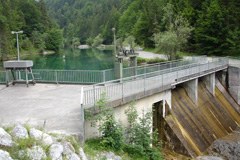News
Alpine riverine landscapes: connectivity, barriers and fragmentation
Mar 26, 2010
/
CIPRA Internationale Alpenschutzkommission
How strongly is a river landscape fragmented? What are the most important barriers and obstacles in Alpine rivers? These questions are in the focus of the Institute of Ecology from University of Innsbruck within its ECONNECT activities. The results will be visualized with the help of GIS and contacts to regional watershed authorities established for the reduction of barrier impacts and restoration.

Image caption:
The ECONNECT project identifies effective barriers and obstacles within the Alpine riverine landscapes. The way to tackle this task was discussed at the Grenoble workshop. © Universität Innsbruck
Riverine landscapes are important habitats, dispersal and migration routs and corridors for aquatic but also for terrestrial animals and plants. In densely populated areas of the Alps and especially in areas surrounding protected areas riverine landscapes were altered intensively and often degraded in various ways. As a consequence, the natural distribution, movements and migration of aquatic and water-bound organisms is highly disturbed or inhibited. Work package 5 aims at improving this situation by analysing the potential to increase connectivity and decrease barrier effects and fragmentation.
In a first step barriers are analysed that are effective in the longitudinal, lateral, vertical and temporal dimensions of river systems. Fragmentation indices are applied for the visualisation of fragmentation. In parallel, typical habitats and riverine species (brown trout, grayling, bullhead, tamarisk, …) are identified. Potential barriers that can have an impact on the habitat and movements of these species will be visualised on maps.
In the present project period, work focuses on specific pilot regions. Effective barriers and obstacles within the riverine landscapes will be identified and contacts to regional watershed authorities established for the reduction of barrier impacts and restoration. More details on the method can be found on www.econnectproject.eu
In a first step barriers are analysed that are effective in the longitudinal, lateral, vertical and temporal dimensions of river systems. Fragmentation indices are applied for the visualisation of fragmentation. In parallel, typical habitats and riverine species (brown trout, grayling, bullhead, tamarisk, …) are identified. Potential barriers that can have an impact on the habitat and movements of these species will be visualised on maps.
In the present project period, work focuses on specific pilot regions. Effective barriers and obstacles within the riverine landscapes will be identified and contacts to regional watershed authorities established for the reduction of barrier impacts and restoration. More details on the method can be found on www.econnectproject.eu

